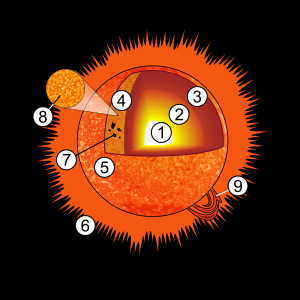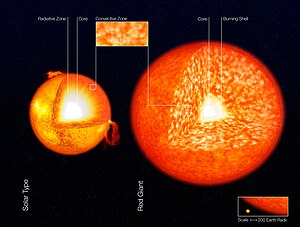Convection zone: Difference between revisions
Appearance
Content deleted Content added
ClueBot NG (talk | contribs) m Reverting possible vandalism by 216.134.175.26 to version by ZéroBot. False positive? Report it. Thanks, ClueBot NG. (1380980) (Bot) |
No edit summary |
||
| Line 3: | Line 3: | ||
The '''convection zone''' of a [[star]] is the range of [[radii]] in which energy is transported primarily by [[convection]]. In the [[radiation zone]], energy is transported by radiation. Stellar convection consists of mass movement of plasma within the star which usually forms a circular convection current with the heated plasma ascending and the cooled plasma descending. |
The '''convection zone''' of a [[star]] is the range of [[radii]] in which energy is transported primarily by [[convection]]. In the [[radiation zone]], energy is transported by radiation. Stellar convection consists of mass movement of plasma within the star which usually forms a circular convection current with the heated plasma ascending and the cooled plasma descending. |
||
donuts. :)physics)|solar granulation.]] Low mass main sequences of stars, such as [[red dwarf]]s below 0.35 [[solar mass]]es,<ref name=aaa496_3_787>{{cite journal |
|||
The [[Schwarzschild criterion]] expresses the conditions under which a region of a star is unstable to convection. A parcel of gas that rises slightly will find itself in an environment of lower pressure than the one it came from. As a result, the parcel will expand and cool. If the rising parcel cools to a lower temperature than its new surroundings, so that it has a higher density than the surrounding gas, then its lack of buoyancy will cause it to sink back to where it came from. However, if the [[temperature]] [[gradient]] is steep enough (i. e. the temperature changes rapidly with distance from the center of the star), or if the gas has a very high [[heat capacity]] (i. e. its temperature changes relatively slowly as it expands) then the rising parcel of gas will remain warmer and less dense than its new surroundings even after expanding and cooling. Its buoyancy will then cause it to continue to rise. The region of the star in which this happens is the convection zone. |
|||
In stars more than 1.3 times the mass of the Sun, the nuclear fusion of hydrogen into helium occurs via [[CNO cycle]] instead of the [[proton-proton chain]]. The CNO process is very temperature sensitive, so the core is very hot but the temperature falls off rapidly. Therefore, the core region forms a convection zone that uniformly mixes the hydrogen fuel with the helium product. The core convection zone of these stars is overlaid by a [[radiation zone]] that is in thermal equilibrium and undergoes little or no mixing.<ref>{{cite web |
|||
| last=Brainerd |
|||
| first=Jim |
|||
| date=February 16, 2005 |
|||
| url=http://www.astrophysicsspectator.com/topics/stars/MainSequence.html |
|||
| title=Main Sequence Stars |
|||
| publisher=The Astrophysics Spectator |
|||
| accessdate=2007-11-25 |
|||
}}</ref> |
|||
In stars of less than about 10 solar masses, the outer envelope of the star contains a region where partial [[ionization]] of [[hydrogen]] and [[helium]] raises the heat capacity. The relatively low temperature in this region simultaneously causes the [[Opacity (optics)|opacity]] due to heavier elements to be high enough to produce a steep temperature gradient. This combination of circumstances produces an outer convection zone, the top of which is visible in the sun as [[Granule (solar physics)|solar granulation.]] Low mass main sequences of stars, such as [[red dwarf]]s below 0.35 [[solar mass]]es,<ref name=aaa496_3_787>{{cite journal |
|||
| last1=Reiners | first1=A. | last2=Basri | first2=G. |
| last1=Reiners | first1=A. | last2=Basri | first2=G. |
||
| title=On the magnetic topology of partially and fully convective stars |
| title=On the magnetic topology of partially and fully convective stars |
||
Revision as of 18:58, 5 December 2012

1. Core
2. Radiative zone
3. Convective zone
4. Photosphere
5. Chromosphere
6. Corona
7. Sunspot
8. Granules
9. Prominence

The convection zone of a star is the range of radii in which energy is transported primarily by convection. In the radiation zone, energy is transported by radiation. Stellar convection consists of mass movement of plasma within the star which usually forms a circular convection current with the heated plasma ascending and the cooled plasma descending.
donuts. :)physics)|solar granulation.]] Low mass main sequences of stars, such as red dwarfs below 0.35 solar masses,[1] as well as pre-main sequence stars on the Hayashi track, are convective throughout and do not contain a radiation zone.
See also
References
- ^ Reiners, A.; Basri, G. (2009). "On the magnetic topology of partially and fully convective stars". Astronomy and Astrophysics. 496 (3): 787–790. arXiv:0901.1659. Bibcode:2009A&A...496..787R. doi:10.1051/0004-6361:200811450.
{{cite journal}}: Unknown parameter|month=ignored (help)
General References
- Hansen, C. J., Kawaler, S. D., & Trimble, V. (2004). Stellar Interiors. Springer. ISBN 0-387-20089-4.
{{cite book}}: CS1 maint: multiple names: authors list (link) - Zeilik, M. & Gregory, S. A. (1998). Introductory Astronomy and Astrophysics. Brooks Cole. ISBN 978-0-03-006228-5.
{{cite book}}: CS1 maint: multiple names: authors list (link)
External links
- Animated explanation of the Convection zone (University of Glamorgan).
- Animated explanation of the temperature and density of the Convection zone (University of Glamorgan).
